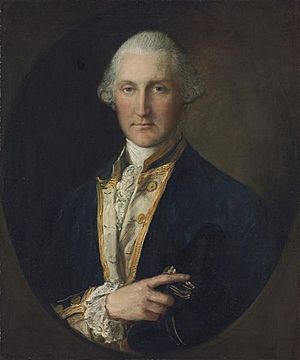Lord William Campbell facts for kids
Quick facts for kids
Lord William Campbell
|
|
|---|---|

portrait by Thomas Gainsborough
|
|
| 30th Governor of South Carolina | |
| In office 18 June 1775 – 15 September 1775 |
|
| Monarch | George III |
| Preceded by | William Bull II (acting) |
| Succeeded by | Henry Laurens (as President of the South Carolina Committee of Safety) |
| Governor of Nova Scotia | |
| In office October 1766 – October 1773 |
|
| Monarch | George III |
| Preceded by | Montague Wilmot |
| Succeeded by | Benjamin Green (acting) |
Lord William Campbell (born 1730, died 1778) was an important British official. He came from a powerful Scottish family that supported the British royal family, known as the House of Hanover. His father was a duke, a very high-ranking noble.
Lord Campbell served in the Royal Navy in India for several years. Later, he was set to serve in America during the Seven Years' War, a big global conflict. In 1763, he married Sarah Izard from South Carolina. Her brother, Ralph Izard, later became an American rebel leader.
After returning to Britain, Lord Campbell became a member of Parliament, which is like the British government's law-making body. From 1766 to 1773, he served as the Governor of Nova Scotia, a British colony in what is now Canada.
Contents
Lord Campbell: Last British Governor of South Carolina
In June 1775, the American Revolutionary War began. Lord Campbell became the last British Governor of South Carolina. He really wanted this job because his wife was from there.
Dealing with Revolutionaries in South Carolina
Lord Campbell's main job was to control the growing number of revolutionaries in the colony. He first tried to ignore the new Provincial Congress. This group was formed by former members of the South Carolina government. They wanted to rule South Carolina independently from Britain.
Campbell knew there was a big difference between the wealthy people in Charleston and the common farmers in the backcountry. He sent out many pamphlets (small booklets) to the backcountry citizens. These pamphlets claimed that the people in Charleston were lying and that the Provincial Congress could not be trusted.
Campbell Flees Charleston
Governor Campbell soon realized it was no longer safe for him to stay in Charleston. American Patriots were using threats and violence against people who supported Britain. They would raid homes and businesses of suspected Loyalists. Even the home of Henry Laurens, a future leader of the American Revolution, was raided.
British officials were being attacked, and some even fled the city to escape. In 1775, Campbell had to leave his home in Charleston. He escaped on a British warship called HMS Tamar and sailed back to England. His departure marked the start of the revolution in South Carolina. It also meant the end of British rule in the colony.
Battle of Sullivan's Island and Campbell's Death
In 1776, Lord Campbell was on a British warship, HMS Bristol, during the Battle of Sullivan's Island. This was an important battle near Charleston. During the fight, he was badly wounded. He never fully recovered from his injuries. Two years later, in 1778, he died at the age of 48 because of these wounds.
Literature About Lord William Campbell
- The History of South Carolina in the Revolution, (volume i, 1901)
- The Carolinian, Rafael Sabatini (1924)

